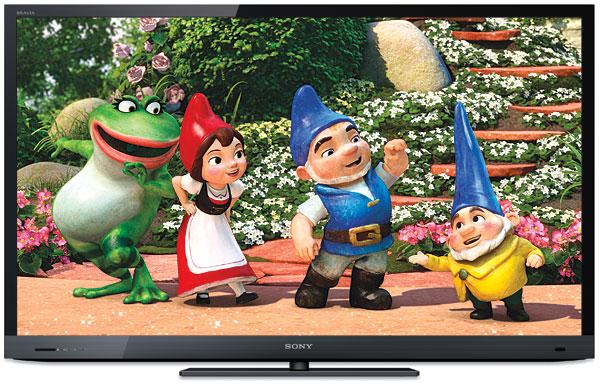Sony Bravia KDL-55EX720 3D LCD HDTV

Order of LEDs on the Side
The movement to replace the traditional fluorescent (CCFL) backlighting for LCD displays with LEDs has become a flood. Sony’s 2011 lineup is dominated by LED-lit LCDs. While the line-topping XBR-HX929 sets have full-array LED backlighting with local dimming, the remainder position their LEDs just beyond the edges of the screen. Aside from lower power consumption compared with CCFL blacklights, LED backlights of either type offer another benefit: They can adjust rapidly in accordance with the changing signal. Edge-lit LED backlights have two primary advantages to manufacturers over the full-array approach that has made them the more widely used. One is lower cost; the other is the ability, at least in some HDTVs, to shrink the depth of the panel to something that seems to approach that of a credit card.
The KDL-EX720 series offers the least expensive Sony 3DTVs. All of the EX720s use fixed LED edge lighting, although our observations indicate that it has at least one dynamic quality—the way it handles fades to total black. For this review, we requested the 55-inch (diagonal) Bravia KDL-55EX720, the largest of the EX720 sets. Despite the unfortunate choice of model number, all of the EX720s are full 1080p. (Sony’s only 720p offerings for 2011 are the 22- and 32-inch BX320s.)
Featured Attractions
So far, the race to produce the thinnest LED edge-lit HDTV has produced one quality in abundance: uneven onscreen light distribution. The edge lighting must be distributed behind the screen by diffusers, and the thinner the screen, the harder it is to do this uniformly. At a bit under 2 inches thick without its stand, the KDL-55EX720 is as slender as anyone might need. While it does have some uneven screen illumination, this is only visible on very dark program material in a darkened room, and then mainly in the corners and, to a lesser degree, the left and right sides. There was no sign of blacks peppered with the streaks and blotches of lighter gray we’ve seen on other edge-lit LCD sets.
The KDL-55EX720 offers 14 Picture modes, seven of them for games, graphics, or photos. I chose the Custom mode for all of my viewing, and I could dial in separate picture settings (including separate gray-scale calibrations) for 2D and 3D. Some of the controls are locked in 3D, particularly the Backlight control; it’s fixed on maximum.
You can adjust most of the video controls individually for each input. I left many of the gee-whiz features off, including the three Noise Reduction controls, Black Corrector, Clear White, Live Color, and Auto Light Limiter (which adjusts the brightness according to the room lighting). The Advanced Contrast Enhancer proved to be effective in adding a little welcome punch to the picture (in the Low setting for 2D, Medium for 3D—higher settings looked garish). Apart from the usual Sharpness control, there are also separate multi-step Detail Enhancement and Edge Enhancement adjustments.

A Gamma control offers settings from –3 to +3. Gamma affects the brightness in the mid-brightness region, leaving the black level and peak white unchanged (in theory). The correct gamma can contribute to producing images with lifelike pop, depth (even in 2D), and saturation. The wrong gamma can result in an image that’s dark and crushed (gamma too high) or flat, bland, and washed out (gamma too low). Ideally, the playback gamma should be the same for all sources. But in practice, the optimum gamma may vary slightly from one source to another, making gamma adjustment a very useful feature.
The set operates at a true refresh rate of 120 hertz in 2D. MotionFlow XR 240 is Sony’s latest take on frame interpolation. It’s available for both 2D and 3D. (Calling it XR 240 with a refresh rate of 120 Hz is a bit misleading, don’t you think?) When engaged in 2D, MotionFlow XR 240 adds four interpolated frames to each real frame in a 1080p/24 source. This brings the onscreen refresh rate up to the set’s native 120 Hz. For 3D, where the frames must alternate between the eyes, displaying each frame an odd number of times (five) will not work. When MotionFlow is engaged with 24-fps 3D content, the source first undergoes 3:2 pulldown, which changes it to 60 fps, and the panel runs at 120 Hz. MotionFlow is said to produce the most aggressive smoothing when the separate CineMotion control is set to Auto 1, but I noticed little difference between Auto 1 and Auto 2.
When MotionFlow is turned off, the Sony simply repeats the added frames rather than interpolate them, and the panel runs at 96 Hz with no 3:2 pulldown to preserve the film-like motion. I find that interpolation kills the traditional look of movies by giving them an oil-like smoothness that film doesn’t have. Apart from checking this feature out (it works as advertised, if that’s your thing), I didn’t use it for the rest of this review.
- Log in or register to post comments





























































